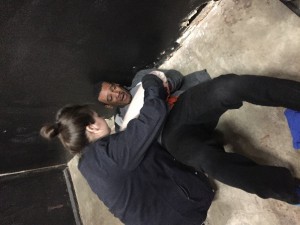
National Security Reporter Lydia Randall engages in a first aid scenario. (Sara Shouhayib/Medill NSJI)
ROCKVILLE, Md. — The danger for journalists covering conflict zones has grown more volatile, according to a number of veteran reporters. The beheadings of James Foley and Steve Sotloff by the Islamic State show that reporting in under-covered areas torn apart by war, terrorism and poverty can be deadly.
Updated safety and security measures are needed in order to better ensure the safety of journalists as they head out to cover chaotic regions like Africa and the Middle East where groups such as the Islamic State, Boko Haram, al-Qaida and the Taliban operate.
Frank Smyth, founder of Global Journalist Security, has spent several years advising journalists, human rights defenders and NGOs on how to better care for themselves in hostile environments. Smyth himself was held captive for 18 days while covering Iraq in 1991.
For years, in cases of terrorist abductions, Smyth advised against attempting an escape because terrorist organizations were “well-organized militias” and usually took hostages in order to get ransom money or information. But the extremism shown by today’s terrorist groups has caused Smyth to tell trainees to consider escape. But even then, “the chances are slim,” he said.
Smyth’s program has grown more relevant in the industry of journalism over the past several years. Representatives from TIME, NPR and VICE were attending a recent training. Smyth said that wire services and many major news organizations are requiring hostile environment training for their journalists before sending them to conflict areas.
The team at Global Journalist Security is diverse. Sara Salam is a self-care practitioner and a level 5 Krav Maga instructor. Salam guides trainees to develop risk-assessment skills when going into new and potentially dangerous settings. Salam also teaches procedures that can help reporters de-escalate or escape situations as large as a riot or as small as street harassment.
Most people have an intrinsic power of “gut instinct,” the Global Journalist Security instructors said, and they encourage the ability to listen to your gut, because it might be the difference between safety and harm.
Journalists in the course run through increasingly intensified scenarios such as being in terrorist captivity or needing to provide emergency first-aid.
The need for professional training to be better prepared for hostile environments like conflicts areas has become a bigger movement in the world of journalism as a whole.
David Rohde, an editor at Reuters and a Pulitzer Prize-winning journalist who was abducted, is among a group of international journalists who published a call to action for reporters and news organizations to better equip themselves for what he called “historic highs” for reporter abduction, imprisonment and killings.
“We call on governments, combatants and groups worldwide to respect the neutrality of journalists and immediately end the cycle of impunity surrounding attacks on journalists,” Rohde said.
Rohde also said that it important for news organizations executives who are not in the field with their reporters to hold themselves to a higher degree of accountability when overseeing the safety of their reporters.





